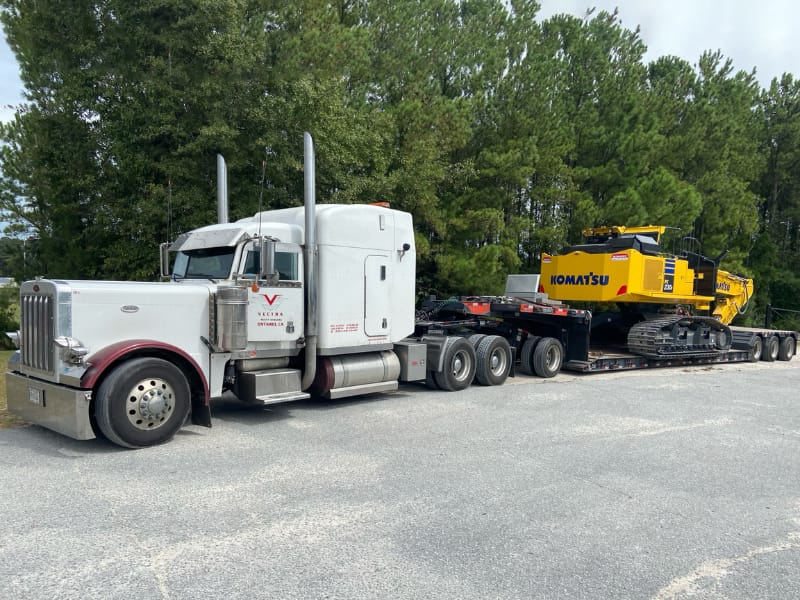Dealing with Nova Scotia spring weight restrictions can be a significant hurdle for truckers and heavy haulers. These annual rules, essential for preserving road integrity during the vulnerable thaw season, often complicate logistics and transport schedules. This guide explains what you need to understand about these seasonal limits and how Vectra Heavy Haulers offer effective solutions to keep your shipments moving.
Spring thaw periods render roads particularly susceptible to damage. As the frozen ground thaws from the surface downwards, trapped water beneath the pavement softens the roadbed, reducing its load-bearing capacity. Heavy vehicle traffic on these weakened roads can cause cracking, potholes, and rutting, leading to costly repairs and safety hazards.
To mitigate this, Nova Scotia’s Department of Public Works, like authorities in many other jurisdictions, implements spring weight restrictions (SWRs), often referred to as “axle weight restrictions.” These temporary reductions in allowable vehicle weights help protect the province’s extensive road network. While crucial for infrastructure longevity, these restrictions inevitably affect trucking companies and any business relying on heavy transport.
Understanding Nova Scotia Spring Weight Restrictions
The Department of Public Works in Nova Scotia announces these restrictions annually. They typically commence in late February or early March and can extend into May, with the precise timing heavily dependent on weather conditions and the progression of the thaw. The province is often divided into several zones, allowing for a staggered implementation and lifting of restrictions based on local frost penetration and thawing rates.
This zoned approach acknowledges that thawing does not occur uniformly across Nova Scotia. Coastal areas might thaw earlier than inland regions or higher elevations. By managing restrictions zone by zone, authorities aim to minimize disruption while maximizing road protection.
Here’s a general overview of how these restrictions function:
- Standard legal axle weight limits are typically reduced. The reduction can vary but often means that only a certain percentage of the normal legal axle weight is permitted on restricted roads.
- Many secondary and local roads are affected, while some primary highways (100-series) may remain unrestricted or have different limitations.
- Specific lists of restricted and unrestricted roads are published by the province well in advance. It’s vital for trucking companies to consult these lists carefully.
- Exemptions might be available for certain essential services, such as heating fuel delivery, emergency vehicles, or agricultural transport under specific conditions, but these require application and approval.
Violations of spring weight restrictions can result in substantial fines and can also lead to vehicles being detained until their load is lightened or conditions change. Therefore, adherence is paramount for all heavy-haul operations. Information about these restrictions, including start and end dates for different zones and lists of affected roads, is usually available on the Nova Scotia government’s official website, a critical resource for logistics planners and drivers.
How Nova Scotia Spring Weight Restrictions Impact Heavy Haulers
For heavy hauliers and trucking companies, these seasonal weight restrictions present considerable operational challenges. The direct consequence is a reduction in the payload that can be legally transported per trip. This often means more journeys are required to move the same total volume of goods, increasing fuel consumption, driver hours, and overall wear and tear on vehicles.
Several common issues arise for the heavy haul sector:
- The necessity to identify and use alternate routes to bypass restricted roads, which are often longer and may involve less suitable secondary roads.
- Increased frequency of trips due to lighter load capacities, directly impacting project timelines and delivery schedules.
- The risk of significant financial penalties and legal issues if weight limits are exceeded, accidentally or otherwise.
- Complications in scheduling due to time-of-day restrictions that may apply in some areas or simply due to the longer transit times.
- Increased demand and potentially higher costs for pilot car services, especially if oversized loads are forced onto narrower, more complex alternative routes requiring escorts for safety.
These difficulties can cascade through entire supply chains. Construction projects might experience delays in receiving heavy materials or equipment. Manufacturing facilities could face interruptions in the supply of raw components. Retailers and distributors may find it harder to maintain inventory levels if goods cannot be transported efficiently.
Vectra Heavy Haulers: Your Solution for Spring Weight Restrictions
This is precisely where a specialized carrier like Vectra Heavy Haulers provides critical support. We have extensive experience in managing the intricacies of Nova Scotia’s spring weight restrictions. Our team possesses deep knowledge of the regulations and how to maintain efficient and compliant cargo movement.
Vectra Heavy Haulers can assist in several key ways:
Expert Route Planning
Our logistics specialists stay constantly updated on all restriction zones, effective dates, and specific road classifications. We meticulously plan routes that effectively avoid restricted segments where possible or account for them in the load planning. This strategic approach can save considerable time, reduce fuel costs, and prevent the severe penalties associated with violations.
Specialized Equipment
We operate a diverse fleet of vehicles and trailers engineered for optimal weight distribution. This includes multi-axle trailers (e.g., 7-axle, 9-axle, or even 13-axle configurations) that spread the load over a greater number of contact points with the road. Lightweight trailer construction materials also allow for a higher cargo weight within the legal limits. Specialized suspension systems on our equipment help minimize the dynamic impact on road surfaces, which is a factor in road wear.
Flexible Scheduling and Operations
We understand that flexibility is crucial during restriction periods. Our team works diligently to schedule movements during non-restricted hours, if applicable, or to coordinate with authorities for movements under special conditions. This adaptive approach means your goods keep moving when other operations might be forced to halt or face significant delays.
Permit Management and Liaison
There are situations where transporting oversized or overweight loads is unavoidable, even during spring weight restrictions. Vectra Heavy Haulers has a strong track record in securing the necessary special permits from provincial and municipal authorities. We understand the application process’s documentation requirements and can often facilitate smoother approvals due to our established relationships and reputation for compliance.
Tips for Dealing with Nova Scotia Spring Weight Restrictions
Even with a proficient partner like Vectra, proactive measures on your part can significantly ease the impact of spring weight restrictions. Here are some practical tips for businesses:
Plan Far Ahead
Do not wait until restrictions are announced or imminent to adjust your logistics strategies. Begin planning for alternate routes, revised schedules, and potential load adjustments well in advance, ideally months before the typical thaw season. Reviewing historical restriction periods can provide insights into likely affected areas and timelines.
Optimize Inventory Management
If your business operations allow, consider increasing inventory levels of essential materials or finished goods before the restriction period begins. This can create a buffer against potential supply chain disruptions. Adequate and accessible storage space is a key consideration for this strategy.
Communicate Clearly with All Partners
Keep your customers, suppliers, and internal teams well-informed about potential delays or adjustments to delivery schedules caused by spring weight restrictions. Transparent communication helps manage expectations and maintain strong business relationships. Providing realistic timelines based on the known restrictions is far better than overpromising and under-delivering.
Explore Intermodal Transport Options
In some scenarios, incorporating other modes of transport, such as rail or marine shipping, for part of the journey can help circumvent heavily restricted road sections. While intermodal solutions add complexity, they can be cost-effective and efficient for certain types of cargo and routes. A thorough feasibility study is important to assess this option.
Stay Informed with Technology
Utilize technology and online resources to stay current. The Nova Scotia government website is the primary source for restriction updates. Additionally, various mapping and logistics software can help in planning routes that account for current restrictions.
The Critical Role of Connectivity and Information Access
In today’s logistics environment, access to timely information is paramount, especially when dealing with dynamic situations like spring weight restrictions. Trucking companies and their drivers rely heavily on consistent communication for updates on road conditions, restriction changes, and route adjustments. This is where the quality of broadband coverage becomes a significant factor.
Many parts of rural Nova Scotia, like rural areas in other regions, including parts of the United Kingdom or even South Dakota in the United States, still face challenges with reliable high-speed broadband coverage. This can impact a driver’s ability to access critical data updates, use GPS effectively, or communicate with dispatch and pilot car services. Issues with achieving the advertised speed for mobile broadband versus the actual speed experienced can hinder the download speed needed for maps or documents.
Initiatives by governmental bodies, sometimes broadly termed a communications commission or federal communications authority, aim to improve broadband deployment. A comprehensive broadband progress report often highlights disparities between urban and rural households. Improving fixed broadband and mobile broadband infrastructure is essential, not just for general public use but for supporting industries like heavy haul trucking that operate across wide geographical areas. While places like Hong Kong or the Czech Republic might boast high broadband subscription rates and advanced digital infrastructure, ensuring similar access in less densely populated areas remains a global challenge. Access to a reliable broadband portal for official updates, rather than relying on sporadic news, is becoming increasingly important. Issues like packet loss on a poor connection can disrupt vital communications. Improvements in broadband data improvement programs are thus beneficial for logistics. Reliable communication and data access also support the coordination required by various phone plans used by logistics teams. A better broadband price and various pricing plans can make these services more accessible.
Efforts by bodies like the European Commission through its Digital Agenda, or national programs aimed at improving fixed broadband speeds and overall broadband services, show a recognition of this need. The ultimate goal is often achieving universal basic broadband or even high-speed broadband coverage, which would greatly benefit logistics operators who need consistent, real-time information flow. Studying how various countries manage their broadband pricing and usage limits can offer insights. The data from resources like the OECD broadband statistics or specific studies (e.g., a hypothetical “fourth ibdr” or similar international broadband progress report) helps track advancements in advanced telecommunications capability and highlight areas needing more focus, especially for rural high-speed broadband. Reliable speed test results can show the gap between advertised and actual speed broadband coverage.
The Environmental Impact of Spring Weight Restrictions
While the operational adjustments due to spring weight restrictions can be demanding, their underlying purpose—road protection—carries significant environmental benefits. Preserving the integrity of road surfaces during the vulnerable spring thaw period contributes positively to environmental sustainability in several ways.
Firstly, reduced road damage means a decreased need for frequent repairs and resurfacing. The production of asphalt and concrete, as well as the operation of heavy machinery for road construction, are resource-intensive and generate greenhouse gas emissions. By extending the lifespan of roads, SWRs help conserve these resources and lower the carbon footprint associated with road maintenance.
Secondly, well-maintained roads lead to smoother vehicle operation, which can translate to better fuel efficiency and lower emissions from transport vehicles. Conversely, driving on damaged, uneven surfaces can increase fuel consumption. Protecting nearby ecosystems from issues like excessive road runoff and soil erosion, which can be exacerbated by damaged road infrastructure, is another positive outcome.
By adhering to spring weight restrictions and partnering with experienced, responsible heavy hauliers like Vectra, businesses are not only ensuring legal compliance and operational efficiency. They are also playing a part in broader environmental protection efforts by helping to maintain a sustainable road transport network.
Case Study: How Vectra Heavy Haulers Overcame Spring Restrictions
Consider a scenario involving a significant construction project in a semi-rural part of Nova Scotia. The project required the delivery of several oversized and heavy prefabricated components during the peak of the spring thaw season. The most direct route to the site involved numerous secondary roads that were subject to stringent weight limits, threatening to delay the project by several weeks if conventional transport methods were attempted.
Vectra Heavy Haulers was engaged to find a solution. Our team’s approach involved several steps:
- A detailed route survey identified an alternative path that, while adding approximately 60 km to the journey, primarily utilized roads with higher weight allowances or those not under the strictest spring restrictions.
- We selected specialized multi-axle low-boy trailers from our fleet, specifically designed to distribute the substantial weight of the components more evenly across more axles, thereby minimizing the per-axle load.
- Coordination was made for the transport to occur during specific hours when traffic was lighter and after securing all necessary permits for oversized loads on the chosen route segments. This involved detailed discussions with provincial and municipal transport authorities. Our team managed the entire permit application process, including providing engineering drawings and load distribution plans.
- Where necessary, pilot car services were arranged to ensure safe passage through tighter sections or areas with higher public traffic.
The outcome was successful: the critical components were delivered to the construction site within the revised project timeline, avoiding costly delays for the client. Furthermore, the client avoided the risk of substantial fines and potential damage to their equipment or reputation that could have arisen from attempting to use the restricted direct routes with overweight loads.
Looking Ahead: The Future of Spring Weight Restrictions
As technology advances and our understanding of climate impacts evolves, the methods for managing spring weight restrictions may also change. The core principle of protecting vulnerable infrastructure will remain, but the tools and strategies could become more sophisticated. Several potential future developments could influence how these restrictions are implemented and managed.
We might see more dynamic restriction systems. Instead of fixed dates and zones, restrictions could be adjusted more frequently based on real-time road condition data gathered from embedded road sensors that monitor pavement strength, moisture content, and subsurface temperature. This would allow for more precise application of restrictions, potentially shortening their duration or limiting them to only the most vulnerable sections.
The development and wider adoption of new, more resilient road construction materials could also play a role. Materials that are less susceptible to thaw-weakening could reduce the need for such stringent weight limitations. Additionally, improvements in broadband deployment, particularly enhancing high-speed broadband coverage in rural areas, could support more sophisticated data collection and dissemination systems for road conditions. This is crucial for non-rural areas as well, but especially for ensuring rural high-speed broadband access for logistics networks. International broadband comparisons can spur innovation, looking at progress in various European countries or insights from global broadband subscription data. The aim for better actual speed rather than just advertised speed broadband remains a goal for many broadband providers, especially as usage limits and broadband prices become more scrutinized. This enhanced connectivity could feed into advanced telecommunications capability for traffic management systems. The success of a national broadband plan often depends on addressing these varied factors using reliable data to improve broadband services. Consistent exchange rates also help in international comparisons of broadband pricing. The goal of any digital agenda is usually to improve connectivity and service, benefiting various sectors.
Vectra Heavy Haulers is committed to staying at the forefront of these industry trends. We continuously adapt our strategies and invest in technology to provide the best possible service, regardless of how regulations or environmental conditions develop.
Conclusion
Nova Scotia spring weight restrictions and Vectra Heavy Haulers represent a challenge and a solution, respectively. These seasonal road regulations are a vital and unavoidable aspect of operating in the region, designed to protect valuable infrastructure. However, with a knowledgeable and well-equipped partner, these restrictions do not need to halt your operations or cause undue disruption.
Vectra Heavy Haulers offers the experience, specialized equipment, and adaptable solutions necessary to manage the specific demands of spring weight restrictions. We help your business continue to function effectively, ensuring your heavy loads are transported safely and legally. Do not let seasonal road rules impede your progress; collaborate with Vectra to keep your essential heavy cargo moving, even when roads are at their most delicate.
Remember, the spring season will always introduce unique logistical considerations. With thorough preparation and the right heavy hauling partner, these considerations can be managed effectively, allowing for continued efficiency in your supply chain. This proactive approach ensures that both the roads and your business remain on solid ground.




